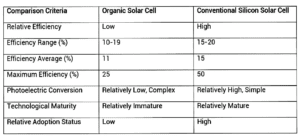Organic Solar Cell Efficiency and Reliability Explained
Organic solar cell efficiency is about 11% on average, and ranges between 10% and 19%%.
This article discusses organic solar cell efficiency and reliability, according to the outline below;
-General Assessment of Organic Solar Cell Efficiency
-The importance of Efficiency in Organic Solar Cells
-Conventional Silicon Solar Cell Vs Organic Solar Cell Efficiency
-Factors that Affect Organic Solar Cell Efficiency
General Assessment of Organic Solar Cell Efficiency
Organic solar cell efficiency is generally moderate; which implies that it is neither extremely low nor high.
There are various factors which can be used to explain the efficiency range of organic solar cells (OSCs).
First is the fact that OSC technology is relatively immature, and has been achieved as a result of numerous efforts to both improve and diversify renewable energy technologies.
Therefore, the advent of organic solar cells can be attributed to the implementation of principles of sustainable development and circular economy. The technology has been modified over the years alongside other sustainable initiatives like wind farms, hydroelectric facilities, geothermal, wave power, artificial intelligence, smart house development, biorefineries, and breeder nuclear reactor technology.

Also, the materials used to produce organic solar cells may vary. Differences in chemical composition and photoelectric behavior can affect the efficiency of these cells.
It is common to find organic solar cell efficiency values of around 10%. However, laboratory-engineered OSC units have achieved much higher efficiencies of 18-25%, under controlled conditions [3].
The importance of Efficiency in Organic Solar Cells
As implied above, the conditions and composition of organic solar cells are important to determine their efficiency.
While it cannot be said that organic solar cells are extremely efficient, the technology is currently capable of performing above average for electricity generation purposes.
Energy efficiency is very important in all energy systems. This is because it determines how much energy will be effectively utilized by these systems, without wastage.
Energy management systems, heat exchangers, electric generators, and cogeneration facilities are all examples of systems whose performance depends entirely on their energy efficiency.
Because energy efficiency affects how much energy is utilized without wastage, it is directly proportional to energy conservation [5]. This means that efficiency determines the economic and environmental sustainability of energy conversion and consumption.
For all types of solar panels and PV cells (including organic solar cells), efficiency determines how much electricity can be generated from a given amount of solar energy [2]. This is also the photoelectric conversion rate.
It implies that when a solar system has efficiency of 10%, this is an indication that it effectively utilizes 10% of the total solar energy that is available, and so forth.
Conventional Silicon Solar Cell Vs Organic Solar Cell Efficiency
Organic solar cell efficiency is currently lower than that of conventional silicon solar cells.
The average efficiency of organic solar cells is 11%, while that of silicon solar cells is 15%.
These values are based on the range of efficiencies for different types of organic solar cells, as well as the range for silicon solar cells.
Organic solar cell efficiency ranges from 10-19%, while silicon solar cell efficiency ranges from 15-20%. In outstanding cases, OSC efficiency can reach 25%, while some silicon solar cells have recorded up to 50% efficiency.
Such cases generally involve PV cells that have undergone chemical engineering in a laboratory, for purposes of experiment; research and development. These have not generally been adopted for practical purposes.
The higher efficiency of silicon solar cells can be attributed to their maturity compared to organic solar cells. Silicon PV technology has undergone more modifications and improvements than OSC technology, and has also advanced due to large-scale adoption.
Lastly, the effectiveness and complexity of the photoelectric conversion process makes silicon solar cells more efficient.
Generally, photoelectric conversion in silicon PV cells is more effective and less complicated than in organic solar cells, as it involves only inorganic materials and processes, and does not require much buildup of charges to transmit the electricity generated.
It is expected that organic solar cell efficiency will increase as the technology undergoes modifications.
The following table summarizes the efficiency comparison between organic and silicon solar cells;

Factors that Affect Organic Solar Cell Efficiency
Factors that affect organic solar cell efficiency are; composition, environmental conditions, and photoelectric conversion mechanism.
These factors affect the instantaneous efficiency of organic solar cells. Other factors that affect efficiency in general include level of technological maturity and adoption.
1). Composition (as a Factor Affecting Organic Solar Cell Efficiency)
Organic solar cells are generally composed of an organic semiconductor layer that is sandwiched between two metallic layers [1].
The metallic layers act as electrodes for transmission (by conduction) of the electricity that is generated by the organic semiconductor. They often include a layer of indium tin oxide (ITO) alongside a calcium, magnesium, or aluminum layer.
The organic semiconductor layer is usually polymeric. Examples of materials used in this layer include poly(3-nethyl-thiophene), and Poly(ortho phenylenediamine) [6].
These materials differ in their efficiencies, and affect the performance of the organic solar cell.
In addition to composition, the design of solar cells also determines their efficiency, with conventional designs being generally more efficient than thin-film models.
2). Environmental Conditions
The efficiency of organic solar cells is affected by environmental conditions like radiation intensity, temperature, altitude, wind energy influence, humidity, and air quality.
Radiation intensity determines how much solar energy is available to generate electricity. This directly influences efficiency.
Other environmental factors may have an indirect effect on efficiency. Factors like humidity and air quality, can affect the ability of the solar cell’s surface to interact with and absorb solar energy.
Regions that are susceptible to high humidity, particulate matter pollution, or desertification, may have low photoelectric efficiency, due to moisture or dust accumulating on the surface of solar panels [4].
Similarly, in regions with high temperature or unfavorable atmospheric chemical composition, organic solar cells are at risk of impairment and may not perform optimally.
Organic solar cell technology can be said to have a cause-effect relationship with the environmental, since solar energy is renewable and can help to reduce the use of energy resources that prevent environmental sustainability by causing greenhouse emissions, climate change, global warming, and other forms of environmental degradation.

3). Conversion Mechanism (as one of the Factors Affecting Organic Solar Cell Efficiency)
Conversion mechanism refers to the process by which solar energy is converted to electricity by an organic solar cell.
The conversion mechanism of OSCs is based on the photoelectric effect, like conventional solar PV cells.
However, organic solar cells utilize a more complex process for photoelectric conversion. This either involves organic electronics (with polymeric semiconductors), or hybrid organic-inorganic electronics (with dye-sensitized photovoltaic units).
The above mechanisms do not apply a unidirectional or simple pathway of photon absorption and electricity generation like silicon solar cells. This relative complexity can reduce the efficiency of conversion and the performance of the solar cell.
Recent developments include efforts to adopt the photoelectric model of silicon semiconductors in OSCs. This can enhance efficiency.
Conclusion
Organic solar cell efficiency ranges from 10-19%, with an average of 11%.
Factors that effect the efficiency of organic solar cells include;
1. Composition
2. Environmental Conditions
3. Conversion Mechanism
References
1). Hoppe, H.; Sariciftci, N. S. (2004). “Organic Solar Cells: An Overview.” Journal of Materials Research 19(7). Available at: https://doi.org/10.1557/JMR.2004.0252. (Accessed 13 September 2022).
2). Kurpaska, S.; Knaga, J.; Latala, H.; Sikora, J; Tomczyk, W. (2018). “Efficiency of solar radiation conversion in photovoltaic panels.” BIO Web of Conferences 10(129):02014. Available at: https://doi.org/10.1051/bioconf/20181002014. (Accessed 13 September 2022).
3). Li, S.; Fu, Q.; Meng, L.; Wan, X.; Ding, L.; Lu, G.; Lu, G.; Yao, Z.; Li, C.; Chen, Y. (2022).“Achieving over 18 % Efficiency Organic Solar Cell Enabled by a ZnO-Based Hybrid Electron Transport Layer with an Operational Lifetime up to 5 Years.“ Angew Chem Int Ed Engl. 2022 Aug 22;61(34):e202207397. Available at: https://doi.org/10.1002/anie.202207397. (Accessed 13 September 2022).
4). Mustafa, R. J.; Gomaa; Dhaifullah, M.; Rezk, H. (2020). “Environmental Impacts on the Performance of Solar Photovoltaic Systems.” Sustainability 12(2):608. Available at: https://doi.org/10.3390/su12020608. (Accessed 13 September 2022).
5). Olughu, O. U. (2021). “Energy Efficiency and Conservation.” IOP Conference Series Earth and Environmental Science 730(1):012026. Available at: https://doi.org/10.1088/1755-1315/730/1/012026. (Accessed 13 September 2022).
6). Zoromba, M.; Abdel-Aziz, M. H.; Bassyouni, M.; Bahaitham, H.; Al-Hossainy, A. F. (2018). “Poly(o-phenylenediamine) thin film for organic solar cell applications.” Journal of Solid State Electrochemistry 22(6). Available at: https://doi.org/10.1007/s10008-018-4077-x. (Accessed 13 September 2022).



